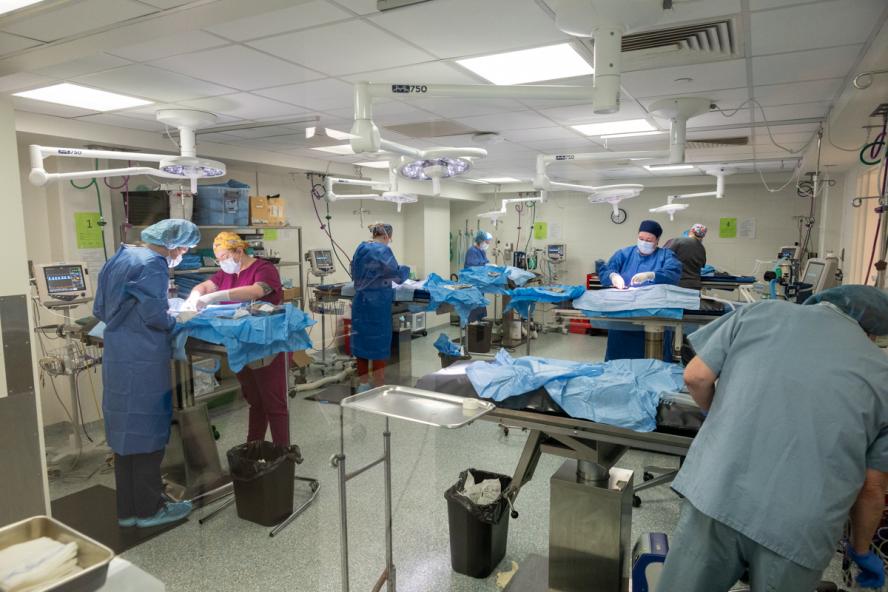-
About
- Leadership & Faculty
- News & Events
-
Academics
- Graduate
- Advanced Clinical Training
- Continuing Education
-
Student Life
- Graduate Programs
-
Research
-
Hospitals & Clinics
- Emergency Care
-
Community Outreach
- Volunteer
Lerner Clinic Helps Out Booming Cat Population
Group Effort by Cummings School of Veterinary Medicine’s Faculty, Staff, Students and Grafton Community

“The day started as a surgery day for me with 44 cats and turned into an incredible learning opportunity for students,” says Dr. Laurence Sawyer, V99, assistant teaching professor in the Department of Clinical Science at Cummings School of Veterinary Medicine at Tufts University.
Twice a month, Cummings School’s Luke and Lily Lerner Spay Neuter Clinic hosts community cat clinics to spay and neuter free-roaming cats. One clinic in February was unusual because the team was responding to a community need.
“It was the greatest experience I’ve had since I started here,” says Dr. Sawyer. “I couldn’t have been more surprised and pleased at how many volunteers showed up. We had four tables going at once, with students volunteering their time to learn and do surgeries. It made me smile to myself: this is why I’m here. It’s such a win-win, all these learning opportunities going on while at the same time helping this cat population.”
Lerner Clinic performs dog and cat spays and neuters, administers vaccinations, performs pre-operative exams and microchip implantations, and provides other veterinary services for shelters, rescue groups, and animal control officers. The clinic also serves as the main training site for Cummings School students, who gain surgical skills as they rotate through the clinic throughout their four years here.
“From sedating animals to prepping for exams, from neutering a cat to scrubbing into surgery, students get the whole experience. It’s exciting seeing the lightbulbs go off as they accomplish new skills,” says Dr. Sawyer.
Dr. Emily McCobb, V00, VG02, is the director of Lerner Clinic. She explains their mission, “It’s all about trying to achieve the best outcomes for animals while also teaching students. It’s a lot of long hours, pitching in, and working towards a common goal. It’s amazing to get to participate in that.”
Lynn Knight, Lerner Clinic Administrator who manages the support staff and oversees students administering anesthesia in the operating room, shares, “The best part of the job is watching the students grow and flourish over the years. Lerner Clinic is a great, safe learning space for students throughout vet school.”
Lerner Clinic’s community cat clinic was launched in 2007 when Cummings School partnered with Merrimack River Feline Rescue Society, one of the first successful trap, neuter, and return programs in the United States.
“Merrimack River Feline Rescue Society was able to completely eliminate a population of cats on the waterfront in Newburyport, Massachusetts, through a model Trap, Neuter, Return Program. It was the first time it was demonstrated that it works to manage a cat population in an urban community. They trained us how to do it,” says Dr. McCobb.
Since the formal launch of Cummings School’s shelter medicine program in 2008, more than 20,000 cats have been spayed and neutered at Lerner Clinic. This effort has successfully decreased cat populations in area shelters while teaching essential skills to veterinary students.
Outreach coordinator Nancy Meyer explains how she typically organizes the community cat clinics, “There’s a pool of trappers who trap cats and manage colonies, who call me regularly and request spots in the community cat clinics.”
A Grafton resident had contacted Animal Control Officer Melinda MacKendrick about a population of outdoor cats quickly becoming unmanageable. MacKendrick contacted Meyer and several trappers, including Theresa Vinic, VG16, who volunteered at Lerner Clinic while earning her M.S. in Animals and Public Policy at Cummings School. Leona Pease, a retired animal control officer from Shrewsbury, also offered to help trap and donate food for the cats.
“Everyone was enthusiastic about helping,” says Meyer.
The first challenge was finding 45 traps. While Cummings School maintains a small bank of traps to loan, Vinic and MacKendrick provided many and borrowed additional traps from Second Chance Animal Services in Worcester. The team set traps and utilized wildlife cameras to place others strategically. The volunteers trapped cats from 6 a.m. until 11 p.m. during the days leading up to the planned clinic day.
They also needed to find a safe, warm place to keep the cats until their surgeries the following day. MacKendrick secured a room at the local police station to hold the cats during the day before transferring them to the Joseph Kelley, D.V.M. Simulation Laboratory at Cummings School, adjacent to Lerner Clinic, for the night.
Dr. Sawyer was the only doctor scheduled that day, so the call was put out for volunteers.
“When we learned how successful the trapping efforts had been, we spread the word, and so many people showed up to help; it was tremendous,” says Knight. “It was an amazing experience, everyone coming together to give back to our community.”
The team spayed and neutered 44 cats and gave each cat a complete physical, administering rabies vaccinations, flea and tick treatments, and cleaning their ears.
“Everyone was in great spirits and really focused because it was such a big task. The day flowed perfectly, and we were able to help,” says Meyer.
Due to the cold weather, the cats spent that night in the Sim Lab while recovering before the volunteers returned them the next day.
“At Tufts, we want to be responsive to our host communities,” says Dr. McCobb. “At Cummings School, that means that we try to have a great partnership with the animal control officers and community cat caretakers.”
Department:
Lerner Spay/Neuter Clinic